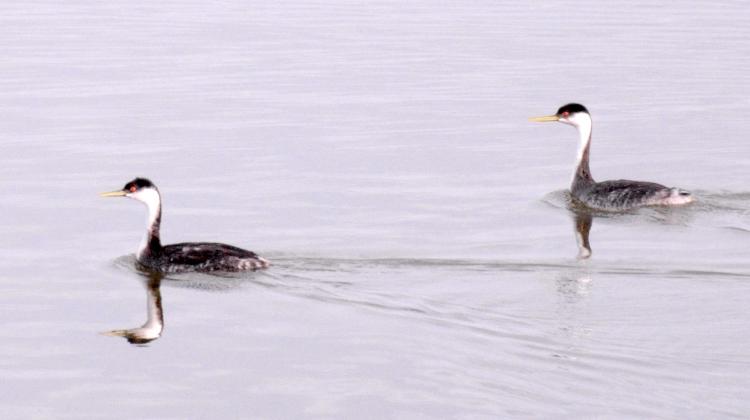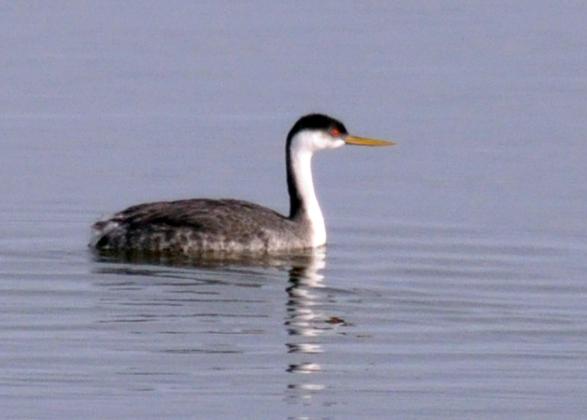A couple of years ago, I featured the Clark’s grebe, a very rare winter visitor to Oklahoma.
In that column, I mentioned the western grebe, which is also a rare winter visitor to Oklahoma, but is seen here a bit more often than the Clark’s, to which it is closely related.
I’ve been reluctant to feature the western grebe, as my photos of the species are subpar, but I think they are good enough to help people distinguish between it and the Clark’s.
Grebes are aquatic diving birds and are very exceptional at maneuvering under water. They do this to hunt for food and avoid predation.
Their look and behavior has fascinated me since I was a kid.
Clark’s and western grebes are very similar in appearance. In fact, until the 1980s, Clark’s grebes were thought to be a light morph of western grebes.
As a young birder, I had seen photos of both species in books and knew that I wanted to see them with my own eyes one day.
Then, around 1987, I saw a pair of western grebes at Hagerman National Wildlife Refuge at Lake Texoma. It was an extremely rare sighting for sure, and when I reported it to refuge staff, they doubted me.
I guess it was because of my young age that they didn’t believe me, but I was 100% confident in my identification.
And to be honest, it was disheartening to be doubted like that.
However, when I returned a week later, many other people had seen the grebes, and it was all the rage. It was sweet vindication, and I saw them first!
However, I didn’t see a western grebe again until many, many years later, when I traveled to Hackberry Flat Wildlife Management Area near Frederick to observe one. It was definitely worth the drive.
And, when I learned there was a pair of western grebes at Waurika Lake this past January, I made the trip there as well.
They were along the dam, and it was wonderful to sit there and watch them for a while. The last report of the birds there was Jan. 22, so they may have moved on.
My advice, if you’re interested in keeping up with rare bird sightings in the state, is to sign up for eBird’s rare bird alerts for Oklahoma. Checking it daily is a good way to know when and where rare birds are being seen.
Grebes, like loons, are specialized for diving in water. Their feet are located far back on their bodies. While they are awkward on land because of the feet location, they are brilliant under the water’s surface, like fish-seeking torpedoes. They have dense, waterproof plumage and lobed toes, which aid in the process.
The dance
Western grebes are known for their spectacular ritualized dance. This dance occurs between a male and female for reassurance of their commitment to each other.
It is smooth and elegant and, at the climax of the dance, the birds stretch out their necks and run across the surface of the water together for quite some distance, then dive into the water. It really is quite spectacular.
I’ve seen it dozens of times on film, but I’ve never witnessed it with my own eyes. It’s definitely on my list of things to see before I die, however.
According to eBird, western grebes have been spotted at least seven times in Comanche County, mostly at Lake Lawtonka.
Appearance
Large, slender black and white grebe with a pale-yellow bill, which is long and thin (photo).
The upper mandible is straight, while the lower mandible curves up slightly near the tip. It sort of makes the bill appear to curve upward. To me, the birds look like they’re smiling.
In winter, the black coloring on the backs of these birds is not as dark as it is during the breeding season (photo).
The way I differentiate between a western and a Clark’s is the black cap of a western extends down below the eyes, whereas on the Clark’s, the black cap doesn’t reach the eyes (photos). Another way to look at it would be the red eyes of the Clark’s grebe are surrounded by white coloring on the face, while the western’s red eyes are surrounded by black.
Also, Clark’s grebes have bills which are more orange than the western’s pale-yellow bill.
Range
As the name implies, western grebes are birds of the American West. Their common breeding range runs from Southern California north well into Canada, east to Michigan and down through Colorado.
They winter along the western coasts of the United States and Mexico, but some individuals stay inland and visit interior lakes.
Food
Mostly fish. However, according to the Cornell Lab of Ornithology, they also eat salamanders, crustaceans, marine worms, grasshoppers and other aquatic insects and larvae.
Habitat
Large freshwater lakes and marshes, the edges of which have emergent vegetation such as reeds and rushes, according to the Cornell Lab. In winter, they can be found along ocean shores and tidal bays, but inland birds inhabit lakes and rivers.
Odds and ends
* According to the Cornell Lab, western and Clark’s grebes were considered the same species until 1985, when scientists discovered that the two species rarely interbreed, despite sometimes living on the same lake. They also make different calls and have substantial DNA differences.
* The Cornell Lab reports that male western grebes generally have longer and thicker bills than females. The difference between the two may permit males and females to feed on different-sized prey, reducing food competition between the sexes.
Hodgepodge
- As I mentioned before, a good way to know what’s going on in the state, birdwise, is to sign up for alerts at eBird: https://ebird.org/alerts. There have been a lot of rare sightings so far this winter.
- I made and posted a video of the visit to Waurika Lake to my YouTube channel. To view the video, which includes footage of western grebes, visit https://www.youtube.com/watch?v=qXIqicWY6mk. And don’t forget to subscribe. It’s free!
Editor’s Note: Randy Mitchell is a freelance writer and photographer. He has been an avid birdwatcher, nature enthusiast and photographer for more than 40 years. Reach him at rnw@usa.com.



